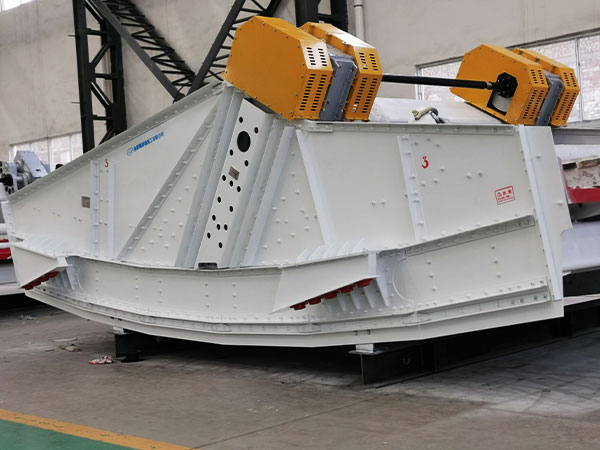What are the vibrating screen techniques?
The process in which the broken material is divided into different particle sizes through one or several layers of sieve surface is called sieving. The vibrating screen is a vibrating screen that uses the relative movement between the bulk material and the screen surface to make some particles pass through the screen holes, and divide sand, gravel, crushed stone and other materials into different grades according to the particle size.
The vibrating screen screening process is generally continuous. After the screening raw materials are fed to the vibrating screen machine (referred to as the sieve), the materials smaller than the sieve size pass through the sieve, which is called the under-sieve product; the material larger than the sieve size passes through the sieve. Continuous discharge on the surface is called over-sieve product.
Vibrating screen machinery is a necessary auxiliary equipment in mine crushing and sand making production lines, and its selection has an important impact on the particle size and grading of the final product.
Factors to be considered in vibrating screen selection:

The characteristics of the sieved material (the content of the size of the material under the sieve, the content of the size of the difficult-to-sieve particles, the content of moisture and clay in the material, the shape of the material, the specific gravity of the material, etc.);
The structure of the vibrating screen (screen area, number of screen layers, size and shape of the screen hole, area ratio of the screen hole, motion mode of the vibrating screen, amplitude and frequency, etc.);
Requirements of beneficiation process (processing capacity, screening efficiency, screening method, vibrating screen inclination), etc.
In addition to considering the above effects, the following basic principles should also be observed:
(1) After determining the sieving area, the width of the sieve surface should be at least 2.5 to 3 times the size of the largest piece of material to prevent the sieve from being blocked by large pieces of material.
(2) In order for the sieve to be in a good working condition, the ratio of the length to the width of the sieve should be selected within the range of 2 to 3.
(3) Reasonable screen material and structure suitable for working conditions should be selected.

(4) Determination of sieve hole size. For fine sieves, curved sieves, and linear vibrating screens for fine particle screening, the sieve size is 2 to 2.2 times the separation particle size, and the maximum is not more than 3 times; for vibrating screens, For screening medium-grained materials, the sieve size is 1.2 times the separation size; for coarse-grained materials, the sieve size is 1.05 of the separation size; for probability sieves, the sieve size is generally the actual separation size 2 to 2.5 times the particle size.
(5) Determine whether to use double-layer or multi-layer sieves. When the particle size range of the material to be screened is wide, when the double-layer screen is used as a single-layer screen, the processing capacity of the vibrating screen can be improved, and the lower screen can be protected, so that the service life of the lower screen can be extended. The selection of the mesh size of the upper screen of the double-layer screen should generally be determined according to the characteristics of the ore feed particle size, and the material particle size equivalent to 55-65% of the original feed amount can be considered as the screen hole according to the underscreen amount of the upper screen. size.
Note that when the content of the under-sieve particle size in the raw material exceeds 50%, there are many difficult-to-sieve particles, and the material has a lot of viscous mud and high water content, try to avoid using double-layer sieves as single-layer sieves.

(6) Determine the effective working area of the sieve. The sieving area calculated according to the requirements of the production process is the effective area of the sieve, and the specification of the sieve is the nominal area of the sieve. For vibrating screens used for screening medium-sized materials, the effective sieving area should be 0.8 to 0.85 of the nominal area of the sieve. times. Of course, this is closely related to the opening ratio of the sieve holes on the sieve surface.
(7) For materials above 200mm, heavy-duty vibrating screens are mostly used; for materials above 10mm, circular motion screens are mostly used; linear vibrating screens and high-frequency vibrating screens are mostly used for desliming, dehydration and classification.
(8) When conditions permit, seat screens should be preferred to facilitate inspection and maintenance. When the hanging screen must be selected, the lifting height should be reduced as much as possible to reduce the swing range of the vibrating screen and facilitate production operations.
In short, when choosing a vibrating screen, you should not only consider one reason, but fully consider various factors to ensure that you choose the equipment that suits your working conditions.


